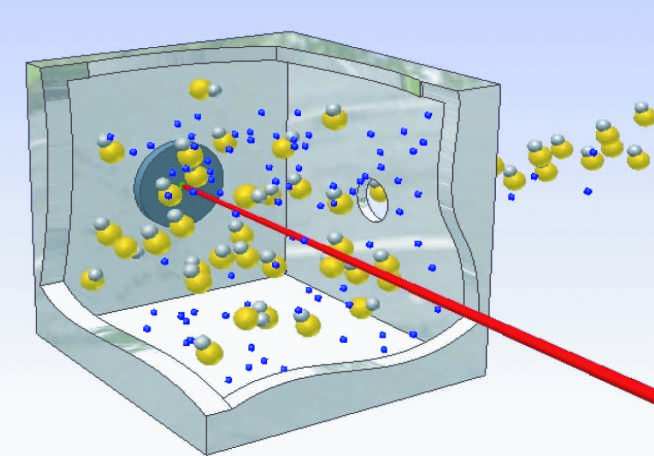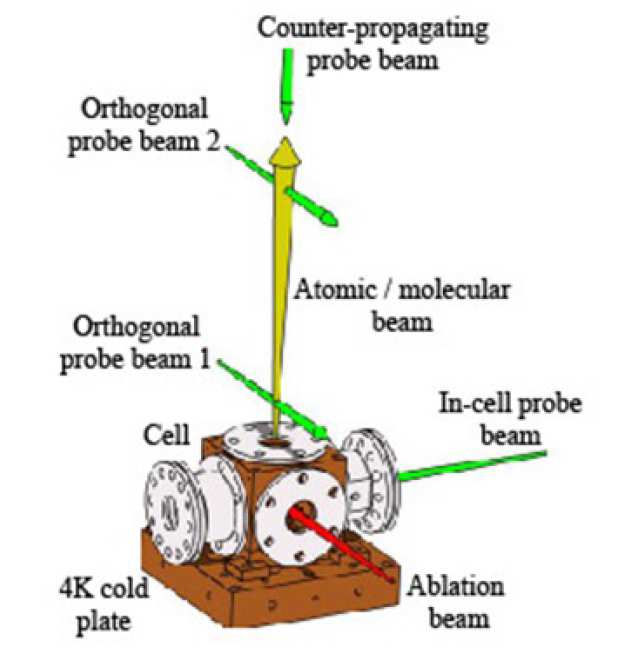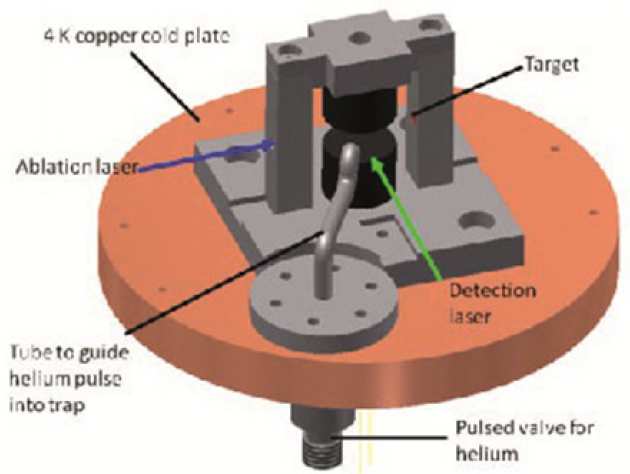
Buffer gas cooling is a powerful new way of producing beams of cold, slow-moving molecules. In our experiments, the molecules of interest are produced by laser ablation of a suitable precursor target, inside a buffer gas cell containing helium gas at low temperature. The hot molecules thermalize with the cold helium. They can then be allowed to escape through a hole in the wall of the cell and transported to an experiment using either a magnetic or an electric guide. This technique is capable of producing high fluxes of cold molecules, moving at low speed in the lab.
Buffer Gas Cooling
 We have characterized the beams of atoms and molecules produced from our buffer gas source using a combination of absorption imaging, absorption spectroscopy, and laser-induced fluorescence. A pulse of molecules is emitted from the cell with a duration of about 5ms, forming an intense, highly collimated beam. The speed can be varied between about 60m/s and 200m/s by varying the flow rate of helium. The temperature of the molecules in the beam is typically 3K. We will use the buffer gas source to replace the room temperature supersonic sources currently used in our electron electric dipole moment experiment, and in our experiments on laser cooling of molecules.
We have characterized the beams of atoms and molecules produced from our buffer gas source using a combination of absorption imaging, absorption spectroscopy, and laser-induced fluorescence. A pulse of molecules is emitted from the cell with a duration of about 5ms, forming an intense, highly collimated beam. The speed can be varied between about 60m/s and 200m/s by varying the flow rate of helium. The temperature of the molecules in the beam is typically 3K. We will use the buffer gas source to replace the room temperature supersonic sources currently used in our electron electric dipole moment experiment, and in our experiments on laser cooling of molecules.
We have also built cryogenic sources where the flow of helium is pulsed instead of continuous. These sources produce much shorter pulses of molecules which are well suited for loading into molecular decelerators. We have used this kind of source to demonstrate the deceleration of YbF molecules using a travelling trap electric decelerator.
 We have recently started buffer gas cooling of molecules and atoms directly in a permanent magnetic trap. We have designed a quadrupole trap using NdFeB magnets, which give a trap depth of 0.4 K for YbF molecules. The whole trap arrangement sits on the 4 K cold head of a cryo-cooler. Inside the trap the molecules are created via laser ablation of a solid target and are cooled with helium gas that is pulsed into the trapping region through a solenoid valve. The cold tail of the Boltzmann distribution is then trapped in the magnetic field minimum at the center of the trap. We test the loading of the trap using laser absorption and laser fluorescence spectroscopy.
We have recently started buffer gas cooling of molecules and atoms directly in a permanent magnetic trap. We have designed a quadrupole trap using NdFeB magnets, which give a trap depth of 0.4 K for YbF molecules. The whole trap arrangement sits on the 4 K cold head of a cryo-cooler. Inside the trap the molecules are created via laser ablation of a solid target and are cooled with helium gas that is pulsed into the trapping region through a solenoid valve. The cold tail of the Boltzmann distribution is then trapped in the magnetic field minimum at the center of the trap. We test the loading of the trap using laser absorption and laser fluorescence spectroscopy.
Characterization of a cryogenic beam source for atoms and molecules, N.E. Bulleid, S.M. Skoff, R.J. Hendricks, B.E. Sauer, E.A. Hinds and M.R. Tarbutt, Phys. Chem. Chem. Phys. 15, 12299 (2013)
Diffusion, thermalization, and optical pumping of YbF molecules in a cold buffer-gas cell,S. M. Skoff, R. J. Hendricks, C. D. J. Sinclair, J. J. Hudson, D. M. Segal, B. E. Sauer, E. A. Hinds and M. R. Tarbutt, Physical Review A 83, 023418 (2011)